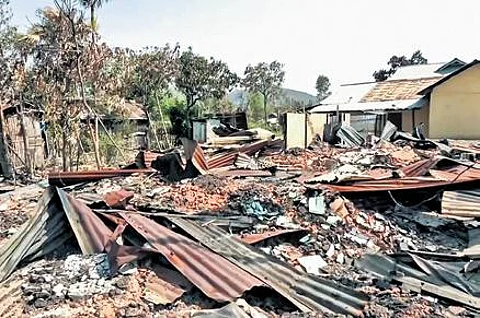

If there is anything that the recent ultraviolence in Manipur has highlighted, it is what a byzantine and knotted mess the entire issue of tribe and caste has become. Aside from those of demonstrably autochthonous origin, who deserves the Scheduled Tribe status? Do all tribes deserve the perks of being scheduled? Can Scheduled Tribe (ST) and Scheduled Caste (SC) statuses be invested in a single social entity? Must an ST identify as Hindu to get SC status? Most perplexing of all, who deserves the Other Backward Class (OBC) status, which is vexedly loosely defined?
There are seven Scheduled Castes in Manipur and 34 Scheduled Tribes. Although the Meitei have SC and OBC status, they are not among the ST—and they have been agitating for a presence in that category for years.
But the demand’s unapologetically straightforward economic and not tribal basis leaves observers both perplexed and uneasy. The Meitei call for ST status has everything to do with the fact that they, who constitute 53% of the population of the state, are by law required to restrict themselves to living on 10% of Manipur’s landmass, the Valley, while the rest 90% is designated for the hill tribes. The Meitei cannot buy property in the hills, but the hill tribes can buy property anywhere in the state. (It is another matter that the overwhelming legislative power and economic pelf of the Meitei ensures the containment of the tribes to the hills.)
In short, the violence in Manipur was all about the buying of land and righteousness about Lebensraum. The other benefits of an ST status—reservation in services, admission to educational institutions, scholarships and fellowships, concessional loans from the National Scheduled Tribes Finance and Development Corporation, etc—are incidental. The Meitei not only have predominant economic heft but also 40 of the 60 seats (or two-thirds) in the state Assembly.
All the seven SCs in Manipur are distributed among the Meitei, who are predominantly Hindu (Vaishnav Brahmins, or Bamons). Muslim (Pangal) constitute 8.4%, and about 1.06% are Christian.
In Manipur, the Meitei (who include the Meitei Brahmin, Meitei/Meetei Sanamahi, Rajkumar, Nepalese-origin Badi, Damai, Gainay, Kami, Sarki, Telis, and the Muslim Pangal) were given OBC status in 1991, except for just over 3% who were given SC status. In all, there are 177 OBCs in Manipur.
One side of the problem is that the Meitei community wants ST status for all its 34 constituent tribes, even those who are SC and OBC. The other side is that the extant STs in Manipur—the 34 cognate tribes of the Kuki-Zomi and the Naga—do not want the tribally heterogeneous Meitei, a community rather than a monoethnic tribe, marked as a single tribe.
But the Meitei are hardly alone in wanting an extra slice of the affirmative-action cake that the government apportions between the three demographics of the SC, the ST, and the OBC.
The OBC Nishad in Uttar Pradesh have been asking to be included in the SC list; after the Supreme Court in 2015 removed Jats from the Central list of OBCs on the grounds that politically organised communities cannot be included in it, Jats in many states have been demanding to be reincluded in the list; the Kurmis of West Bengal, classified as OBCs, are seeking reclassification as ST; and the OBC Dhangar in Maharashtra have been demanding insertion in the ST list. This has led Maharashtra’s Vanvasi Kalyan Ashram, which propagates the welfare of tribal communities across India, to file a Special Leave Petition in the Supreme Court disputing the wisdom of giving ST status to a significant 13% of the state’s population.
The Meitei, on their part, comprise more than half of Manipur’s population. In Assam, six communities—Koch-Rajbongshi, Tai-Ahom, Chutia, Matak, Moran, and the Tea Tribes (all OBCs who comprise a third of the population of the state)—have been demanding ST status. Ranged against them are the existing nine STs—Mising, Bodo, Karbi, Kuki, Dimasa, Deori, Tiwa, Sonowal Kachari, and Rava—protesting that the STs would then comprise more than half the state, whittling down the benefits and privileges the STs share among themselves under Article 46 of the Constitution.
In Manipur, too, the hill tribals argue that giving the Meitei ST status would granularise their entitlements to vanishingly little.
While the Constitution itself mentions no identifiers for ST categorisation, the 1965 Lokur Committee recommended five criteria for identification: primitive traits, distinct culture, geographical isolation, shyness of contact with the larger community, and backwardness. These criteria are accepted as a writ by the Union Ministry of Tribal Affairs. The Meitei fit none of these requirements.
The term OBC is a misnomer, in that it has come to be predicated less on class—an economic signifier ubiquitised by Marxian thought—and more on caste. OBCs are today castes that fall between the three higher varnas and the Dalits (SC) and Adivasis (ST). It’s a vast demographic that has fallen prey to politicians, the politicoeconomics of reservations, and its own sense of deservingness (and even meritoriousness).
Marc Galanter wrote in his Who are the Other Backward Classes - An Introduction to a Constitutional Puzzle: “The Other Backward Classes for whom preferential treatment is authorised are not defined in the Constitution, nor is any exclusive method or agency for their designation provided. … At the time of Independence, the term ‘Backward Classes’ had a less fixed and definite reference. It had been around for some time, but it had a variety of referents, it had shifted rapidly in meaning and had come to mean different things in different places.”
The ST and the SC carry unmistakable sociohistorical markers; the OBC have always been difficult to pin down. What are the odds of the ST now becoming just as fluid in form and content?
Kajal Basu
Veteran journalist
(kajalrbasu@gmail.com)